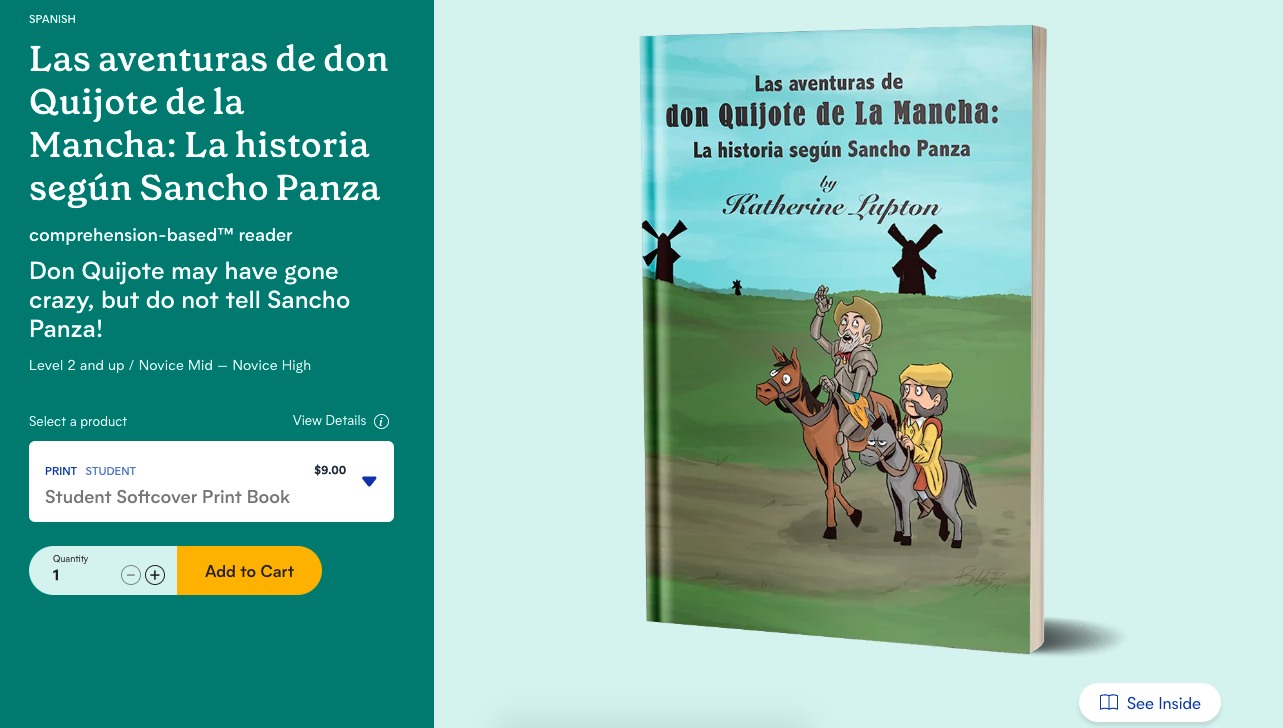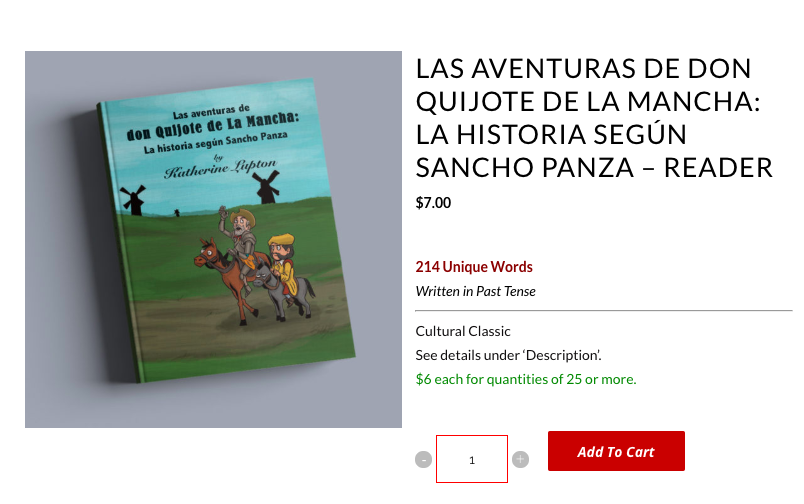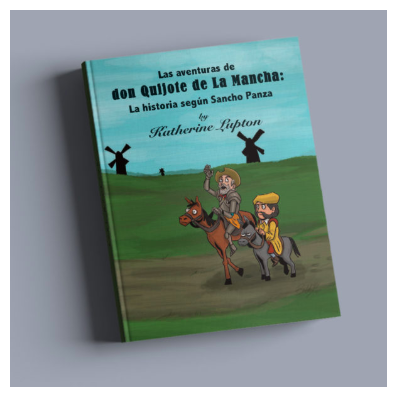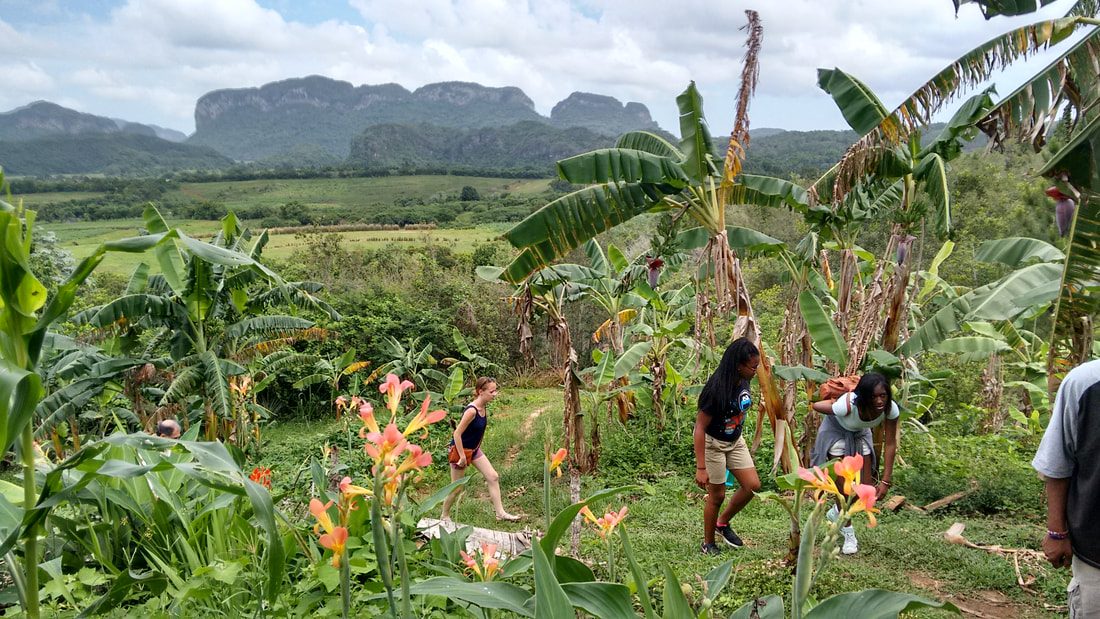- Home
- About
-
Lessons
-
Teaching with Music
>
- Song warm-up lesson plans, setup, procedure, and exams
- How to teach "Tú sí sabes quererme" by Natalia Lafourcade
- How to teach "La Carretera" by Prince Royce
- How to teach "Latinoamérica" by Calle 13
- How to teach "Prohibido Olvidar" by Rubén Blades
- How to teach "Traidora" by Gente de Zona
- How to teach "La Bicicleta" by Shakira and Carlos Vives
- How to teach "Culpa al Corazón" by Prince Royce
- How to teach "Déjà Vu" by Prince Royce and Shakira
- How to teach "Amor de Mis Amores" by Natalia LaFourcade
- How to teach "Despacito" by Luis Fonsi and Daddy Yankee
- Teaching with TPRS >
- Teaching with Tech >
- Teaching with Film >
- Teaching Social Justice >
-
Teaching with Music
>
-
Service Learning
-
Travel
- Resources
- Tutoring
- Blog
- Contact
 I am excited to announce that my novel, Las aventuras de don Quijote de la Mancha: La historia según Sancho Panza, is now being published through Wayside Publishing. Wayside Publishing purchased the group Fluency Matters last year- so all of the classic comprehensible novels that you know and love can be found at their website. Including Las aventuras de don Quijote de la Mancha: La historia según Sancho Panza ! Head over to Wayside Publishing now to take a look!
0 Comments
I am delighted to share that my novel was published yesterday in collaboration with the publisher Fluency Matters!
After over a year of writing and editing, this comprehension-based Spanish reader is now available to students and individuals who are looking to further their Spanish skills and learn a bit about epic friendship of don Quijote and Sancho Panza along the way. This unique take on the story tells the tale from the perspective of don Quijote's loyal squire, Sancho Panza. Although Sancho is often portrayed in popular literature as dim-witted and simple, the Sancho of Miguel de Cervantes' novel has the common sense and intelligence that holds together the adventures of don Quijote. In short, don Quijote's adventures would have never been possible without the clever Sancho! It was an honor working with the talented team at Fluency Matters, and I can't wait to see what projects the future may bring. Take a look at the novel, and please consider purchasing a copy for yourself or for your classroom! https://fluencymatters.com/product/las-aventuras-de-don-quijote-de-la-mancha-la-historia-segun-sancho-panza-reader/ On this very rainy Wednesday (here in Portland, Oregon at least) I am excited to share a fantastic new song resource with you! Have you heard the new tune "16" by Kurt and Luis Fonsi that came out in August? If you haven't, you should take a listen as soon as possible!
Not only does this new tune feature Luis Fonsi of "Despacito" fame, but it is a Spanish 2+ teacher's dream song. Why is that, you ask? Well, take a minute to take a look at the lyrics. This tune is FULL of great examples of the preterite and imperfect tenses. Check out the chorus, for example: Quiero volver A esos momentos donde todo era posible Donde había días de sol y menos días grises Poder volver a esos años, otra vez Cuando tenía 16 This is also a great tune for practicing stating age in the imperfect tense. In my classroom, I used this song warm-up to introduce my students to the differences between the preterite and imperfect (which is no simple task!) As far as I'm concerned, you might as well make it a bit easier by having them memorize this catchy song first. :) In addition, the song is accompanied by a beautiful music video, and is slow enough for students to understand the lyrics without feeling frustrated. What's not to love? Check out the new song resource on my Teachers Pay Teachers Store by clicking here. Hoping it is sunny today wherever you are teaching- and if not, that you are enjoying the last few rainy days of summer! Hello all,
Thank you for following The Immersive Classroom and supporting my work! In honor of "Black Friday in July" (a.k.a Prime Day), The Immersive Classroom is offering both a 20% off sale store-wide, and a FREE Comprehensible Classics Unit (a value of $10)! In this Comprensible Classics unit, "Fuenteovejuna and Lope de Vega", students will learn about this famous play, about the life of Lope de Vega, and all about the Golden Age of Spain, completely in the target language. This comprehensible unit provides resources completely in the target language, and includes readings, activities and exams. This 25-page resource includes day-by-day lesson plans and instructions, as well as all readings, worksheets, activities and exams needed to complete the unit. So, what's the catch? This 25-page resource and 20% off sale will only be offered for the next four days (through July 18th), so hurry and take advantage of this offer while it lasts! On July 19th, the Comprehensible Classics unit will return to the original price of $10. Before I go, I just want to take a moment to say thank you for being a loyal follower and customer- I couldn't do it without you!! To get further ideas and inspiration, please visit my website (www.theimmersiveclassroom.com) and sign up for the newsletter. And keep your eye out for another Comprehensible Classics unit coming in the next two weeks! Happy summer to you and your family! Un abrazo, Katherine  Today, I am excited to announce a new series of comprehensible input resources from The Immersive Classroom. The series, Comprehensible Classics, is a set of resources that will help the Spanish language teacher to guide students through the stories and contexts of Spanish and Latin American literature's great works. The first of the series, Fuenteovejuna by Lope de Vega, provides teachers with 9 days of lesson plans which center around the story, the author, and the context of this great dramatic work from the Golden Age of Spain. In this unit, students will learn about the play Fuenteovejuna, the life of Lope de Vega, and the Golden Age of Spain, completely in the target language. This comprehensible unit will provide students with resources completely in the target language, through readings, activities and exams written in the preterite and imperfect tenses. This 30-page resource includes day-by-day lesson plans and instructions, as well as all readings, worksheets, activities and exams needed to complete the unit. I chose Lope de Vega's Fuenteovejuna not only because of the play's fame in the canon of Hispanic literature. I think that this is a play all students should know because of the incredibly strong female lead, Laurencia, who is featured prominently throughout the play.
In this unit, students will have an opportunity to analyze one of Laurencia's most famous speeches in the play, and will develop an appreciation for Lope de Vega's strong and independent female characters. I hope you enjoy this unit as much as my students and I did! Check out the resource by clicking here. Stay tuned for the next Comprehensible Classics unit, coming in the next two weeks! Hope you are enjoying your summer, whether you are teaching summer school, traveling, or taking a much deserved break from the classroom. xoxo, Katherine  ;During my time teaching in foreign language classrooms, I have come to love teaching through comprehensible input and TPRS. In fact, as soon as I first learned about the two methods, I was hooked! I started reading every teaching blog I could find about the subject. Soon, I was quizzing all of the languages teachers I knew about comprehensible input and TPRS (Teaching Proficiency through Reading and Storytelling), trying to make sense of how to integrate both practices into my own classroom. You see, I was not taught through the comprehensible input method. As a student at a public school in Oregon, I was largely taught through textbooks and the Skill-Building Hypothesis. While I was extremely passionate about languages, even from a young age, I found my Spanish classes to be very frustrating. My teachers seemed to speak mostly in English in the classroom, and my textbooks focused on grammar specifics rather than teaching for fluency. I achieved Spanish fluency over years of travel through Cuba, Mexico and Spain, and especially while living in Madrid for two years. I found that while the background in Spanish that I had from classes helped a bit while I was living abroad, I could feel the limitations of my education in my daily efforts to communicate. So- back to comprehensible input. When I arrived at my first university teaching post, I was quite disappointed to see that the curriculum was based on an expensive textbook; a textbook that focused heavily on grammar, rather than focusing on student fluency. I found that not only were the cost of the textbook and online component a barrier to entry for students, but the traditional grammar-based instructional method promoted by the textbook is also serves as a barrier to entry. So I started doing some research of my own, to back up my reasoning for why the comprehensible input approach works so well for students learning foreign languages. Throughout my research I found an incredible number of resources that supported the use of comprehensible input in the classroom, which made me really question why our university was still teaching through the textbook and grammar based method. In the Hispania article “Approaches to Grammar Instruction in Teaching Materials: A Study in Current L2 Beginning-level Spanish Textbooks”, Claudia Fernández states: “techniques for grammar instruction that include the provision of comprehensible input… and that provide opportunities to use the [second language] in meaningful, communicative ways are seen as the most effective ways to help learners acquire the grammar of the target language” (Fernández 156). It might help to provide some background of the two teaching methods that I am comparing. At my university, we are currently using a “Skill-Building Hypothesis” model (or grammar-based model) in our Spanish language courses that are based on the PANORAMA: Introducción a la lengua española (5th Edition) textbook. I strongly feel that these instructional methods should be updated to match current best practice research, which is exemplified in the “Comprehension Hypothesis” model (a model which supports the case for the comprehensible input instructional method). The “Comprehension Hypothesis” model was first published in 1977 by Dr. Stephen Krashen, an Emeritus Professor of Education at the University of California, and the Comprehensible Input method which developed from the model has been in use in foreign language classrooms for the last forty years. At one time, the field of language education was based on the Skill-Building Hypothesis. However, evidence shows that Skill-Building cannot be the means by which humans acquire language, and there is doubt that Skill-Building plays more than a minor peripheral role in language use (Krashen 2011). Nevertheless, Skill-Building remains an assumption for many language classes and materials (Krashen 2011). According to Dr. Stephen Krashen, the traditional “Skill-Building Hypothesis” says that we learn language by first “learning grammar rules and memorizing vocabulary” and that we “make these rules of new words automatic by producing them in speech or writing, and we fine-tune our (conscious) knowledge of grammar and vocabulary by getting our errors corrected” (Krashen 2017). On the other hand, the “Comprehension Hypothesis” says that we acquire language when we understand what we hear or read. Our mastery of the individual components of language ("skills") is the result of getting comprehensible input (Krashen 2017). This method has been proven to be highly successful with university level students in the United States, and is the method that I have proposed that the Spanish 101 – 103 sequence evolve to in order to reduce the barrier to entry for first year students at our school. In the study “The effectiveness of two comprehensible-input approaches to foreign language instruction at the intermediate level”, fourth semester students of Spanish as a foreign language at the university level in the United States participated in two kinds of comprehensible-input based instruction, an extensive reading class that combined assigned and self-selected reading, and a ”Reading-Discussion” class that consisted of assigned reading, debates and discussions. Students in both classes outperformed those in a traditionally taught class on a checklist vocabulary test and on a grammar test. The results “confirm the efficacy of comprehensible-input based pedagogy at the intermediate level” (Rodrigo, et al). I hope that this post has given you a bit more information about why the comprehensible input method is a great choice for teaching in foreign language classrooms. If you'd like to read more about my proposal for the revised Spanish sequence at my university, check out my last blog post here. Thanks for reading, and happy Wednesday! Works Cited: Aski, Janice M. (2003). Foreign Language Textbook Activities: Keeping Pace with Second Language Acquisition Research. Foreign Language Annals, 36(1), 57-65. Bragger, Jeannette, and Donald Rice. (2000). “Foreign Language Materials: Yesterday, Today, and Tomorrow.” Agents of Change in a Changing Age. Ed. Robert Terry. Lincolnwood, IL: National Textbook Company. 107–40. Print. Dorwick, T., & Glass, W. (2003). Language Education Policies: One Publisher's Perspective. The Modern Language Journal, 87(4), 592-594. Fernandez, Claudia. (2011). Approaches to Grammar Instruction in Teaching Materials: A Study in Current L2 Beginning-Level Spanish Textbooks. Hispania, 94(1), 155-170. Krashen, Stephen. (2011). “Seeking a Justification for Skill-Building”. KOTESOL Proceedings 2011. 13 – 20. Krashen, S. (1981). Second language acquisition and second language learning. New York: Prentice Hall. Larsen-Freeman, Diane. (2003). Teaching Language: From Grammar to Grammarian. Boston: Thomson Heinle. Print. Rodrigo, Victoria, Krashen, Stephen, & Gribbons, Barry. (2004). The Effectiveness of Two Comprehensible-Input Approaches to Foreign Language Instruction at the Intermediate Level. System: An International Journal of Educational Technology and Applied Linguistics, 32(1), 53-60. 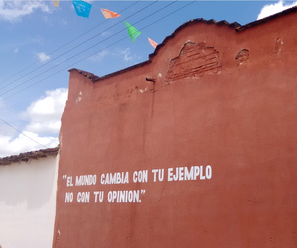 In December of 2018 I had the pleasure of creating a proposal for a new 100-level Spanish sequence at Portland State University through the Office of Academic Innovation. It was a very exciting opportunity, and I was honored to be asked to present my proposal at the Certificate of Innovation in College Teaching conference in 2019. First, a bit of background information on the college level Spanish sequence that I have been teaching for the past two years, and will continue to teach this summer. During my time teaching and studying at Portland State University, I have observed that increasing student retention is an important goal for any department, and is an especially important focus in the World Languages and Literatures (WLL) department at our institution. Student retention in foreign language classrooms has become an increasingly prioritized topic nationwide, as new data shows that from 2013 to 2016, higher education in aggregate lost 651 foreign-language programs (Johnson 2019). In our World Languages and Literatures department, the greatest loss of students is from the 101 course to the 102 course, despite the fact that the majority of those students who drop after 101 have received A or B grades. It is of the utmost importance to improve student retention, and this matter has been given high priority within the College of Liberal Arts and Sciences (CLAS) and within the WLL department itself. Student retention is not only advantageous for the department, however. Portland State University requires two years of coursework in a foreign language to graduate with a Bachelor of Arts degree, and two terms of foreign language to graduate with a Bachelor of Science degree. Seeing as language courses are a requirement for graduation at PSU means that student retention in the WLL department for may make the difference between a student who graduates from PSU, and a student who drops out before completing the degree. I have taught the Spanish 101 – 103 sequence for the last five consecutive terms. During this time I have observed that the course requirement of the sequence, of purchasing the PANORAMA: Introducción a la lengua española (5th Edition) textbook and online access code, serves as a barrier to entry for a course that is a graduation requirement for many students at Portland State University. This prohibitive cost has caused many of my students each term to drop the course in the first few weeks, after realizing that they cannot afford to purchase the online access code and/or textbook. The course as it stands, with the course structure being guided by the PANORAMA: Introducción a la lengua española (5th Edition) textbook, is not sustainable and does not promote student success and retention in Portland State University’s language program. In the World Languages Department, the Spanish 101 – 103 program serves approximately 500 students in any given term. This means that each academic year, the Spanish 101-103 program serves upwards of 1,500 students. The cost of the text for this course is $246.75. This includes both the textbook, as well as the online access code to “Supersite”, which each student is required to purchase. The cost of the online access code alone is $155.00 and is a required component of the course. It is not possible to buy a used access code, or to loan an access code from the library. If a student takes only one of the courses in the Spanish 101 – 103 sequence, that student must also pay the full price for the access code and/or textbook. Not only are the PANORAMA: Introducción a la lengua española (5th Edition) textbook and online access code prohibitively expensive, but the course materials do not serve student success or promote student fluency. Through this textbook, students learn the Spanish language through instructions and grammar presentations in English, which is a huge deterrent for students who are studying the language to become fluent and use the language in the workforce. Unfortunately, this is a common practice among textbooks that are used in the university setting. According to an article from the journal Hispania, “the traditional way of teaching grammar with the presentation-production practice model (or grammar-based model) (Larsen-Freeman 2003) is no longer advocated because presenting grammar rules explicitly and manipulating them through drills or decontextualized production practice does not engage the cognitive processes necessary for grammar acquisition (Fernández 155). In this study, Fernández found that explicit grammar instruction supplied by the teacher or the textbook may be obtrusive for communication because it usually requires learners to focus on the form before experiencing its meaning (Fernández 157). In her article, Fernández states that perhaps the “main reason” for the current state of grammar-based textbooks in the university setting, as addressed by several scholars, is the “prevalent conservatism of the profession” (Aski 2003; Bragger and Rice 2000; Dorwick and Glass 2003). Language instructors are not willing yet to let go of traditional ways of teaching grammar, and this situation is reflected in the approaches to grammar found in the textbooks (Fernández 166).  In addition, the order of the grammar that is taught in the textbook does not align with student success or fluency. In my courses, I have seen students become easily frustrated with the textbook and struggle to understand simple concepts, due to the fact that the order that the grammar is presented in the book is not congruent with student success with or mastery of the language. And now, it's time for a bit of information about my proposed solution for the 100-level Spanish sequence. In December of 2018, I proposed that the PANORAMA: Introducción a la lengua española (5th Edition) textbook should be replaced with an option that is cost-effective and promotes student fluency. I believe that a straightforward solution would be to introduce graded readers to the curriculum. I have proposed that at least one graded reader be taught in Spanish 101, one in Spanish 102 and two in Spanish 103, for a total cost of $24 per student for the entire Spanish 101 – 103 sequence.  Graded readers are books written especially for students of Spanish as a foreign language, which adhere to the comprehensible input instructional method. The comprehensible input method refers to language that is intelligible but just a bit more advanced than the student's current ability to understand it. This means that the overall message of the language should be clear, even though some words and grammatical structures might be unfamiliar. Graded readers offer students the opportunity to learn via the comprehensible input instructional method, and cost only $7 when purchased individually, or $6 when purchased in a larger purchase order. The publishing company Fluency Matters has published over fifty graded readers, and also provides comprehensive Teacher’s Guides to guide classroom instruction day by day. Click here to see a full list of the graded readers available through the Fluency Matters website. In addition, I have proposed that the online, app-based program “Duolingo” replace the online access code “Supersite” (https://schools.duolingo.com/). Duolingo, which is free for both teachers and students, largely eliminates the barrier to entry cost of the current textbook and online component “Supersite”, while improving the course structure to promote student fluency in the language. The teacher dashboard component of Duolingo shows completed skill levels, as well as the number of days the student was active. Skill levels plus XPs (points earned while completing lessons) give guidelines of student progress (Techman 2015). As a classroom tool, teachers can opt to receive weekly skill and lesson summary reports. In addition, Duolingo encourages students to engage with each other through friendly competition, which promotes student engagement and retention. So what are the steps involved making the proposal a reality for Spanish students in the university setting? 1. Re-write existing course structure and syllabus to include one graded reader in Spanish 101, one in Spanish 102 and two in Spanish 103. The revised syllabus will also include Duolingo as the online homework component of the course. 2. Choose supplemental materials to enhance the instruction of the novels (especially in Spanish 101). Select at least one higher-level reader for Spanish 103 (authors such as García Marquez, García Lorca, Laura Esquivel). 3. Revise existing mid-term and final exams to reflect the communicative nature and end goals of the course. 4. Purchase instructor’s manuals for the department and develop a day-by-day curriculum based around the course novel(s) (approximate cost for an instructor’s manual - $99). 5. Train instructors on the benefits of the comprehensible input method and how to conduct a class period while teaching through comprehensible input. In a nutshell, what are the benefits of a revised college level Spanish curriculum?
To conclude... After six years of teaching through the comprehensible method or “Comprehension Hypothesis” and two years teaching through the “Skill-Building Hypothesis”, I feel very strongly that college level students will be better served through a revised curriculum and course structure in the Spanish 101, 102 and 103 courses. Stay tuned for my upcoming post highlighting the differences between the “Comprehension Hypothesis” the “Skill-Building Hypothesis”. Thank you for taking a look at my post! Happy Monday, and have a wonderful teaching week! Works Cited:
Aski, Janice M. (2003). Foreign Language Textbook Activities: Keeping Pace with Second Language Acquisition Research. Foreign Language Annals, 36(1), 57-65. Bragger, Jeannette, and Donald Rice. (2000). “Foreign Language Materials: Yesterday, Today, and Tomorrow.” Agents of Change in a Changing Age. Ed. Robert Terry. Lincolnwood, IL: National Textbook Company. 107–40. Print. Dorwick, T., & Glass, W. (2003). Language Education Policies: One Publisher's Perspective. The Modern Language Journal, 87(4), 592-594. Fernandez, Claudia. (2011). Approaches to Grammar Instruction in Teaching Materials: A Study in Current L2 Beginning-Level Spanish Textbooks. Hispania, 94(1), 155-170. Johnson, Steven. “Colleges Lose a ‘Stunning’ 651 Foreign-Languages Programs in 3 Years”. Chronicle. The Chronicle of Higher Education. 22 January 2019. https://www.chronicle.com/article/Colleges-Lose-a-Stunning/245526?fbclid=IwAR08X3B2evKn_YXxj1Wbvi8HhaMmF69eJhIU1wRY25WyKN_T48deJde5KQs Krashen, Stephen. (2011). “Seeking a Justification for Skill-Building”. KOTESOL Proceedings 2011. 13 – 20. Krashen, S. (1981). Second language acquisition and second language learning. New York: Prentice Hall. Larsen-Freeman, Diane. (2003). Teaching Language: From Grammar to Grammarian. Boston: ThomsonHeinle. Print. Rodrigo, Victoria, Krashen, Stephen, & Gribbons, Barry. (2004). The Effectiveness of Two Comprehensible-Input Approaches to Foreign Language Instruction at the Intermediate Level. System: An International Journal of Educational Technology and Applied Linguistics, 32(1), 53-60. SRI International. “New study reveals that OER courses and degrees benefit student retention and completion, improve faculty engagement, and result in cost savings for students”. Achieving the Dream. 12 October 2018. https://www.achievingthedream.org/press_release/17506/new-study-reveals-that-oer-courses-and-degrees-benefit-student-retention-and-completion-improve-faculty-engagement-and-result-in-cost-savings-for-students. Techman, M. (2015). Duolingo for schools, reviewed: Test-driving the popular language-learning program's new educator tool. School Library Journal, 61(3), N/a.  One of best films I have seen this year so far is the gorgeous film "La novia" by the young Spanish director Paula Ortiz. This film was released in 2015, and brilliantly portrays the passion, destruction and tragedy of Federico García Lorca's play Bodas de sangre (Blood weddings). What strikes me as inspiring about this film is the way in which Ortiz tells the story through the eyes of la Novia, the principal female character of Lorca's play. Although Bodas de sangre was written in 1932, it is a play that still connects with the modern reader and effectively highlights the restrictive rules that society places on women. Both the film and Lorca's play take place in southern Spain, where the main character, la Novia, is a young women who is promised to be married to el Novio. The family of el Novio holds a grudge against la Novia, due to her relationship as a young girl with a member of a feuding family. We find, however, that after a passionate decision on the night of her wedding, la Novia embarks on a dangerous journey towards a new life of her own choosing; one that goes against the societal norms with which she has been raised. It is striking to observe Paula Ortiz's focus on the character of La Novia throughout the film. Through her eyes, we see la Novia as an intelligent and caring person, but also a passionate woman who cannot resist the call of her own emotions.
La novia would be an excellent addition to any curriculum, whether it be during a study of Federico García Lorca, a reading of Bodas de sangre, or even a study of Spanish culture in the early 20th century.
Keep your eyes out for two upcoming resources from The Immersive Classroom- a comprehensible input unit based on Bodas de sangre, and a film guide to La novia (coming soon!) If nothing else, please watch this film for yourself! You won't be disappointed. Have a wonderful weekend, and happy teaching!  One of my favorite shows on Netflix is the television series "Celia". I absolutely adore Jeimy Osorio, the actress who plays young Celia in the part of the series. I have found this series to be particularly engaging for both my high school and college students, and have even blogged about it before here. I have now screened the series for both my students in Baltimore and my students and Portland, to rave reviews! If you are looking for an authentic learning tool to aid your student's learning, look no further than this fantastic series. The episode guide for Celia: Episode 1 is available on my Teachers Pay Teachers Store- take a look here! And you can stream "Celia" for free on Netflix. Maybe even throw in a song warm-up of "La vida es un carnaval" for February (find the resource here) to enhance your lesson plan. Just in time for carnaval at the end of the month! I have just completed and posted Celia on Netflix: Episode 5. In this episode, Celia finally gets to meet and talk to the "maestro" of La Sonora, Rogelio. In the most exciting episode yet, it seems that Celia's dreams are on their way to becoming a reality. Take a look at the resource for Episode 5 here.  I hope you enjoy the series as much as my students and I have! Happy teaching! Have you heard the new song "Extranjera" by Claudia Prieto? If not, take a few minutes to listen to it now! This beautiful song will have you and your students singing along in no time. I can't wait to introduce it to my students next week with this song resource.
I envision this resource going along with a unit on Carol Gaab's book Esperanza, and in particular, Chapter 10 of the novel. The novel's theme of immigration would compliment this tune well, as Claudia Prieto focuses on the conflicting feelings of isolation and joy that go along with being an immigrant to a new country. Claudia herself is an immigrant of Colombian and Venezuelan heritage, and her beautiful tune captures well the mixed emotions and challenges that go along with relocating to a new place that is so far away from friends and family. If you haven't listened to this beautiful tune yet, do it now! I am sure that this catchy tune will be stuck in your head in no time. :) Happy teaching! |
HEY THERE! NICE TO MEET YOU!I'm Katherine Lupton: language teacher and author. I live in the lovely state of Oregon. My favorite things include my energetic dogs, music and books (both reading and writing them). Blogs I follow
(and you should, too!) Creative Language Class Cynthia Hitz El Mundo de Birch Fluency Matters Kristy Placido Martina Bex Somewhere to Share |
|
This website is a participant in the Amazon Services LLC Associates Program, an affiliate advertising program designed to provide a means for us to earn fees by linking to Amazon.com and affiliated sites.
|
- Home
- About
-
Lessons
-
Teaching with Music
>
- Song warm-up lesson plans, setup, procedure, and exams
- How to teach "Tú sí sabes quererme" by Natalia Lafourcade
- How to teach "La Carretera" by Prince Royce
- How to teach "Latinoamérica" by Calle 13
- How to teach "Prohibido Olvidar" by Rubén Blades
- How to teach "Traidora" by Gente de Zona
- How to teach "La Bicicleta" by Shakira and Carlos Vives
- How to teach "Culpa al Corazón" by Prince Royce
- How to teach "Déjà Vu" by Prince Royce and Shakira
- How to teach "Amor de Mis Amores" by Natalia LaFourcade
- How to teach "Despacito" by Luis Fonsi and Daddy Yankee
- Teaching with TPRS >
- Teaching with Tech >
- Teaching with Film >
- Teaching Social Justice >
-
Teaching with Music
>
-
Service Learning
-
Travel
- Resources
- Tutoring
- Blog
- Contact
